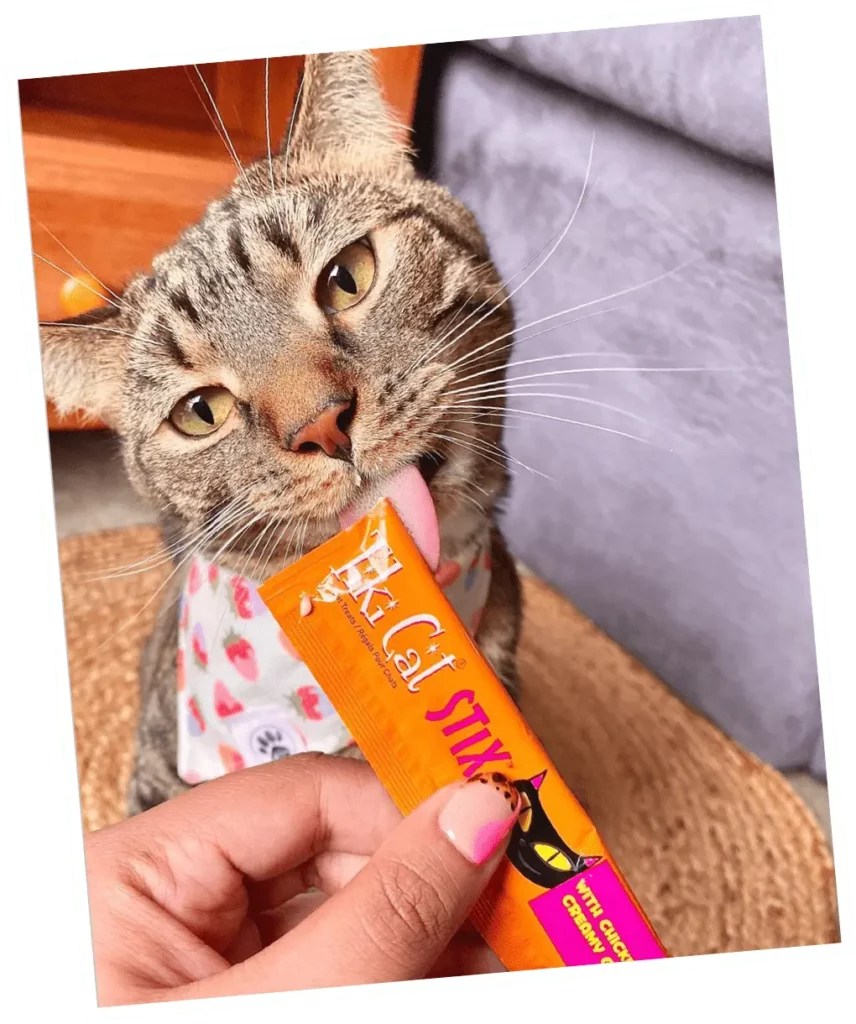Find Answers
Got a question about one of our products? Read our frequently asked questions.
Q) Why do you have organ meat in Tiki Cat After Dark diets?
Organ meats, like Liver, Gizzard and Heart, are nutrient-rich and highly palatable to cats. Cats naturally grasp and tear their food, so they also add an appealing texture.
Q) Why do you have organ meat in Tiki Cat After Dark diets?
Organ meats, like Liver, Gizzard and Heart, are nutrient-rich and highly palatable to cats. Cats naturally grasp and tear their food, so they also add an appealing texture.
Q) Are Tiki Cat Velvet mousse diets complete and balanced?
A) Yes
Q) Do I need to refrigerate Tiki Cat Velvet mousse after opening?
Yes, Tiki Cat Velvet Mousse diets should be refrigerated after opening, and discarded within two days if not used.
Q) Are Tiki Cat Dash treats complete and balanced?
A) No. Tiki Cat Stix treats are meant for supplemental feeding only.
Q) Do I need to refrigerate Tiki Cat Stix treats after opening?
A) Yes. Tiki Cat Stix treats should be refrigerated after opening, and discarded within two days if not used.
Q) Why did you decide to make a dry food for cats?
A) Cats are obligate carnivores and need a meat based, high moisture, low carbohydrate diet to survive and thrive. Tiki® Cat wet foods mimic the natural prey diet with the appropriate levels of protein, fat and moisture. But many cat owners feed dry diets and as many as 60% feed dry exclusively. We formulated a dry option, in a baked kibble, that delivers on the same high protein, low carbohydrate promise that we make with our wet diets.
Q) Why do cats need so much protein?
A) Cats are obligate carnivores and can only get nutrients from meat, unlike other animals which are able to synthesize nutrients from plant-based foods.
Q) How do we really know how much protein is in a food?
A) To determine if a wet or dry diet delivers the protein level the natural prey diet (50% – 60%), you should use a Dry Matter calculation. A Dry Matter (DM) calculation is a measure of the product with the water removed: (100 – Moisture = Dry Matter). It is often used to compare the amount of protein in a wet diet versus a dry diet.
Q) Do you have any concerns with the high protein level in cats with kidney or urinary disease?
A) Tiki Cat® diets are not for therapeutic use and not intended to prevent or treat disease. It should not be fed to cats suffering from kidney or urinary disease without the advice or approval of your veterinarian.
Q) Do you have plans to introduce other proteins?
A) We continue to look for new and unique protein sources that meet the cat’s nutritional needs.
Q) Why is Tiki® Born Carnivore™ baked and not extruded?
A) Baking allows us to include higher levels of fresh meat than extrusion, which is how most dry products are made.
Another benefit of the baking process is the “Maillard” effect which locks in flavor, making the food very palatable for picky cats. The Maillard effect is a reaction between amino acids and reducing sugars that gives browned food its desirable flavor. Seared steaks, pan-fried dumplings, toasted marshmallows, and breads undergo this reaction when cooked.
Q) How is the product made?
A) Baking is a very simple process – just like baking at home except on a much larger scale. The ingredients are mixed into a dough and then shaped into kibbles with a with a mold (like a cookie cutter). The kibbles are baked in the oven for 3.5 minutes at 605 degrees. They are slowly cooled for 20 minutes at 230 degrees and then packed immediately to preserve freshness.
Q) How palatable is the food?
A) Palatability tests comparing Tiki Cat® Born Carnivore™ to top natural brands and top science brands in the pet specialty category resulted in superior performance.
Q) What are processed plant proteins? And why are they not recommended for cats?
A) Cats are carnivores and need meat protein to thrive and survive. Some manufacturers supplement their diets with grain-based ingredients to increase the level of protein. Proteins from grain cannot effectively provide the nutrients your cat needs. Corn Gluten Meal is an example of a processed plant protein. The gluten is extracted from the corn kernel through a chemical process.
Q) The bag says “80% Bioavailable Animal Sources.” What are they and why are they important?
A) This label means that 80% of the raw ingredients come from animal sources: poultry, eggs, and fish. Bioavailability refers to how quickly the nutrients enter the bloodstream for the cat to utilize. Because of your cat’s unique needs, protein from animal sources provides the most “bioavailable” source of these nutrients.
Q) Where do you source the ingredients found in Tiki Pets™ diets?
A) We source our ingredients as close to the manufacturing plant as possible unless we can’t find an ingredient that meets our nutritional or quality specifications. Our choice is intentional as we want to be as respectful of our impact on the environment as possible.
Q) What is the ash content of the food?
A) The ash content of Tiki Cat® Born Carnivore Chicken Luau is 10%. The ash content of Tiki Cat® Born Carnivore Chicken & Fish and Tiki Cat® Born Carnivore Fish Luau is 9.9%.
Q) Can I rotate between varieties?
A) Yes. All Tiki Aloha Friends, Grill, Luau, Velvet Mousse & After Dark diets are complete and balanced, making it safe to rotate flavors and varieties.
Q) Why do the names of ingredients change sometimes?
A) The names of the primary ingredients or vitamins and minerals may change, even when the formula does not change.
AAFCO (American Association of Feed Control Officials) requires that the exact name of the ingredient from each supplier or grower be listed on the label. Different suppliers may use slightly different names for the same ingredients. This is primarily true in vitamins and minerals.
An example of an ingredient name difference is Zinc Supplement and Zinc Amino Acid Chelate. They are both chelated Zinc, but because they come from a different supplier the name is different.
Q) Why are the calories and feeding instructions different for each diet?
A) Calories come mainly from protein and fat and AAFCO requires that all pet food labels declare the number of calories in the diet. If the source of protein or the level of fat changes, then the level of calories may change.
At Tiki, we verify our nutrient levels and protein, fat, fiber, moisture and calories in an independent laboratory on a regular basis. We are conservative when we label our products to ensure that your pet gets the calories and nutrients required for health. We are especially conservative because our diets can also be fed to kittens and pregnant and nursing moms and their needs are much greater.
If you are feeding a kitten, pregnant or nursing mother, or feeding a Tiki diet as the exclusive food, you should be sure to feed as recommended. If you are using Tiki as a complement to a dry food, you should feed less than recommended to ensure your cat maintains a healthy weight.
Always consult your veterinarian if you have questions.
Q) Can I feed Aloha Petites to my puppy?
A) Yes, Aloha Petites is formulated for all life stages.
Q) Why is Tiki Dog Aloha Petites kibble baked and not extruded?
A) Baking allows us to include higher levels of fresh meat than extrusion, which is how most products are made. Another benefit of the baking process is the “Maillard” effect which locks in flavor, making the food very palatable. The Maillard effect is a reaction between amino acids and reducing sugars that gives browned food its desirable flavor. Seared steaks, pan-fried dumplings, toasted marshmallows, and breads undergo this reaction when cooked.
Q) How are the kibbles made?
A) Baking is a very simple process – just like baking at home, except on a much larger scale. The ingredients are mixed into a dough and then shaped into kibbles with a with a mold (like a cookie cutter). The kibbles are baked in the oven for 3.5 minutes at 605 degrees. They are slowly dried for 20 minutes at 230 degrees and then packed immediately to preserve freshness.
Q) What are Essential Fatty Acids?
A) Essential fatty acids (EFAs) are fats that must be supplied in the diet. They are called essential because the cat CANNOT produce or convert them within the body. Some acids which are essential for cats are not essential for dogs, since dogs CAN convert them within the body.
Q) What is the purpose of the added flaxseed, since cats have very limited ability to convert ALA into EPA and DHA?
A) Flaxseed is added as a source of Alpha-linolenic acid which is an “essential fatty acid” for cats. Fish and Fish Oil is added as a source of EPA and DHA.
Q) What are the Natural Flavors?
A) Fish Luau contains natural flavors from Salmon and Chicken.
Chicken Luau contains natural flavors from Salmon and Chicken.
Fish & Chicken Luau contains natural flavors from Salmon and Chicken
Q) What is Dried Egg Product?
A) Dehydrated egg, free of shells and other non-egg materials.
Q) Tiki wet diets are manufactured in Thailand. Why?
A) Thailand produces millions of pounds of human food every year for the United States and Europe and has dedicated human-grade certified canning lines. Tiki diets are hand-packed side-by-side with human food diets.
Q) Do the raw materials you use come from sustainable sources?
A) Thailand is at the center of the global fishing industry. Methods of farming and fishing are scrutinized by multiple local and international regulatory agencies and practices are among the best in the world.
Tiki fisheries are members of the International Seafood Sustainability Foundation (ISSF) and support initiatives to protect our marine environments from pollution and damage.
Tiki fisheries are certified by International Dolphin Conservation Program. This certification applies only to Tuna.
Tiki fisheries employ methods that support the preservation of other species, including sea turtles.
Still have a question?
Please send us an email!

